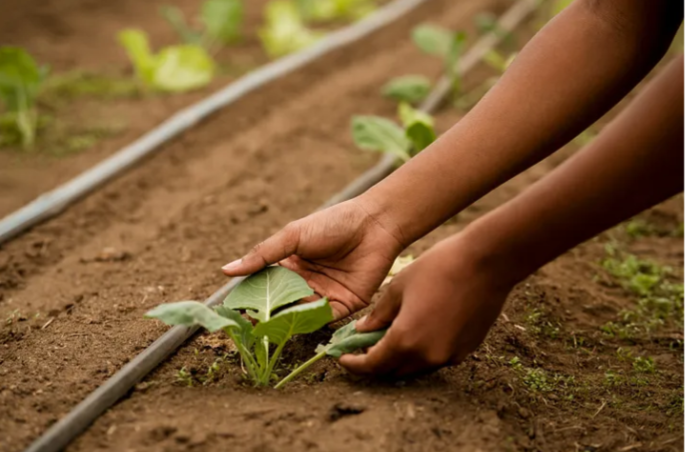
RURAL INFRASTRUCTURE AND AGRICULTURAL DEVELOPMENT
The physical and organizational structures and facilities (such as buildings, roads, and power supply) that are essential for the operation of an organization or society are referred to as its infrastructure. More over half of Nigeria’s entire population calls rural areas home, and the majority of those people work in the agricultural sector which makes farming their primary occupation and primary means of economic support. As a result of this, the rural communities in Nigeria have the potential to make major contributions to the overall socioeconomic development of the nation through the practice of sustainable agriculture. However, unlike in the past, when Nigeria’s agricultural sector was a strong supporter of the economy through the provision of food for the population and raw materials for the industries, general infrastructural deficit and neglect of the rural communities have diminished the attractiveness of agriculture, leaving it for the poor members of the society. This is in contrast to the situation in the past, when agriculture in Nigeria was a strong supporter of the economy through the provision of food for the population and raw materials for the industries. This is largely due to the discovery of crude oil in Nigeria, which has resulted in increased levels of poverty, starvation, malnutrition, and diseases in the country’s rural communities. The government of Nigeria, on the other hand, had made a number of steps toward the development of agriculture. These steps included the establishment of different initiatives both at the federal and state level. The River Basin Development Authority and Anchor Borrowers’ Program along with a number of other initiatives are samples of this program ideas. However, a greater percentage of these development activities’ beneficiaries have always been in the metropolitan and peri-urban centers, while the projects’ effects on the rural areas have been minimal.

Image credit: www.medium.com
Achieving economic growth, bettering rural communities, and reducing poverty in low-income developing countries all depend on agricultural development. A rise in agricultural productivity has far-reaching effects on economic growth and poverty alleviation, both inside and beyond the agricultural sector. To boost productivity, it’s important to have access to the tools necessary to do so, such as a reliable internet connection, computers, printers, scanners, fax machines, and phones, as well as a stable financial system, stable government, and well-developed rural infrastructure. The building of new infrastructure and the upkeep of existing infrastructure do not appear to be priorities for either national governments or foreign assistance groups. The considerable deficits of rural infrastructure in most developing nations persist despite the well-documented usefulness of rural infrastructure to promote growth and decrease poverty and the high economic rates of return on investment in rural infrastructure. Investment in rural infrastructure must be prioritized if poor developing nations are to realize the Sustainable Development Goals and reap the economic benefits of freer commerce, international financial markets, and other aspects of globalization.

Image credit: www.medium.com
Even though poor infrastructure in rural areas and, at times, urban areas has hampered the growth of the agricultural sector, Nigeria as a nation continues to take pride in the fact that it is among the top 10-20 best countries in the production of some crops. These crops include cassava, cashews, maize, and a great many others. Would it have been possible for the country to have become the best if we had better infrastructure? Would we have been able to sell our agricultural products at the lowest possible price if we had better logistics and roads to transport them? What is the result the initiatives gathered and how was it used for the betterment of the agricultural sector?
If only the infrastructure had been a little less challenging, the agriculture industry would have been a guaranteed and abundant success. The majority of the infrastructure was a bust because of poor planning on the part of the organizers. Even now the anchor borrow program might be reaching it breaking point anytime soon if it is not worked on.
With all the national calls for rural development, it’s possible that it won’t happen any time soon. Given our knowledge of the correlation between rural infrastructure and agricultural advancement, we are well aware that we must prioritize the improvement and maintenance of rural infrastructure if we are to see a substantial rise in agricultural production. How can we keep making sure that agricultural production doesn’t go down, even though Nigeria doesn’t have a lot of infrastructure?

Image credit: www.medium.com
• Education for farmers: Because it can cut through all of the ramifications of the sector’s lack of development, education for farmers is a crucial component that cannot be overemphasized. A good education not only imparts information to everyone who has an interest in acquiring it, but it also provides a form of exposure that can assist farmers in developing their mental autonomy and facilitating the accomplishment of more desirable objectives. Farmers need to have the numbers, they need to know how essential their production is for the nation, how they are trailing behind, the volume of production that is needed from them, what they produce more and how to focus on what they produce more, and they need to have access to those numbers. The farmer needs to have access to this information, since it can assist them in developing more effective strategies. Why not assist each local government in concentrating on what they are able to produce more successfully rather than concentrating on all types of crops and, as a result, getting less profit from each? Let all of the farmers focus on the things that matter most to them, and let each local government become known for the things that they excel in. Let all farmers be educated to focus on what they can produce in their community and sell off to profitable market through reliable market channels. Ile-Ife is recognized for her ancient history on Yoruba culture as well as their cocoa production. Oke-ogun is known for their cassava output. A better education for farmers means a better education for everyone else and production of healthier food on everyone’s table.
By means of education, the coping mechanisms for various farmers should be explained, and those explanations should be followed up on in order to guarantee the greatest possible level of productivity from the mechanisms that have been recommended. Farmers may be able to manage with the lack of infrastructure by adopting some innovative coping methods, such as solar power for electricity rather than waiting on the nation’s power grid, as well as many other coping mechanisms that can assist local farmers in producing more food. Farmers can be trained on partnerships as a part of a coping mechanism. For example, if a single farmer is unable to purchase an irrigation machine that costs 5 million Nigerian naira, rather than waiting on public or private funding, he can raise funds with the other farmers in his community to purchase the machines and use them in sequence with an extension agent overseeing the project without favoring one person over the other.

Image credit: www.medium.com
In order to ensure that rural farmers receive an adequate amount of knowledge, extension agents need to have adequate training and access to all of the necessary materials to function effectively in rural environments. Educate farmers on value addition; it is essential for local farmers to be aware of the value that can be added to their product by transforming it from raw materials into a finished good. If a farmer knows the value of a processed commodity, they can be interested in finding ways to add additional value to the raw material they produce.
• Private sector invasion: Invasion of the private sector The private sector, which is comprised of individuals, needs to make its way into the agricultural sector in order to provide services such as access to financial resources and credit facilities, as well as extension agents, human resource services, and consulting services.
In conclusion, rural infrastructure plays a critical role in agricultural development, and there is a need to focus on improving infrastructure in rural areas to support the growth and development of agriculture. As discussed in our blog, investment in infrastructure such as roads, electricity, water supply, and storage facilities can enhance agricultural productivity, reduce post-harvest losses, and increase the incomes of rural farmers.
Our Twitter space recording on rural infrastructure and agricultural development further highlights the importance of this topic and provides valuable insights that can be applied. Through the discussion, we learned that improving rural infrastructure requires a collaborative effort from government, private sector, and civil society organizations. It also requires a long-term perspective and sustained investment to bring about significant changes in rural areas.
Find the Twitter space recording link here.
https://twitter.com/i/spaces/1mnxeRWpDRAKX
Overall, we hope that this blog and our Twitter space recording help to raise awareness about the critical role of rural infrastructure in agricultural development and encourage more action and investment in this area. With better rural infrastructure, we can create a more sustainable and prosperous future for rural communities and the agricultural sector.



